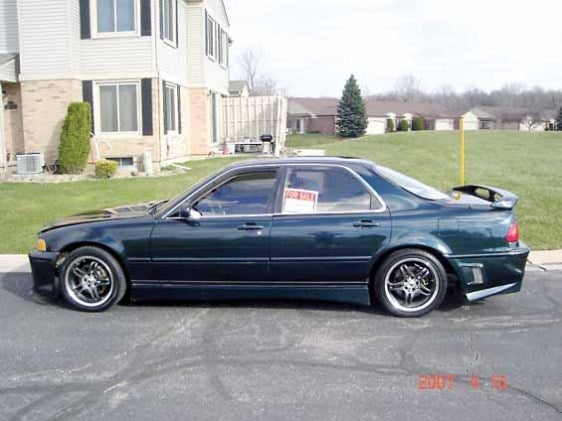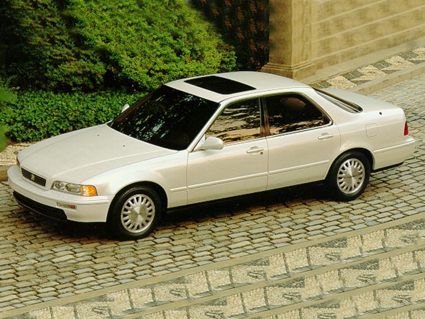 The Acura Legend, sold as the Honda Legend outside the U.S., Canada, and parts of China, was a luxury vehicle sold from 1986 to 1995 as both a sedan and coupe. It was the first flagship sedan sold under the Acura nameplate, until being renamed in 1996 as the Acura 3.5RL. The 3.5RL was North American version of the (KA9) series Honda Legend. In Japan, the Legend was only offered at Honda Clio dealerships.
The Acura Legend, sold as the Honda Legend outside the U.S., Canada, and parts of China, was a luxury vehicle sold from 1986 to 1995 as both a sedan and coupe. It was the first flagship sedan sold under the Acura nameplate, until being renamed in 1996 as the Acura 3.5RL. The 3.5RL was North American version of the (KA9) series Honda Legend. In Japan, the Legend was only offered at Honda Clio dealerships. The opportunity for Japanese manufacturers to export more expensive models had arisen with the 1980s voluntary export restraints, negotiated by the Japanese government and U.S. trade representatives, restricting mainstream car sales.When the Legend made its appearance into the market, rival companies in Europe, Japan and North America took notice, and quickly introduced or revised current products that could be compared to it. Toyota began development in 1983 with the F1 project, the code name for a secret flagship sedan effort that became the Lexus LS, Nissan updated their premium flagship the President initially introduced in 1966, and in 1988 Lincoln took a new approach to the venerable Continental offering for the first time a front wheel drive sedan with a V6 engine. General Motors introduced the GM H platform (FWD) and GM C platform with FWD, Audi took a fresh approach to the 100 and in 1994 introduced the A6, and BMW introduced the BMW 5 Series (E34) in 1988.
The opportunity for Japanese manufacturers to export more expensive models had arisen with the 1980s voluntary export restraints, negotiated by the Japanese government and U.S. trade representatives, restricting mainstream car sales.When the Legend made its appearance into the market, rival companies in Europe, Japan and North America took notice, and quickly introduced or revised current products that could be compared to it. Toyota began development in 1983 with the F1 project, the code name for a secret flagship sedan effort that became the Lexus LS, Nissan updated their premium flagship the President initially introduced in 1966, and in 1988 Lincoln took a new approach to the venerable Continental offering for the first time a front wheel drive sedan with a V6 engine. General Motors introduced the GM H platform (FWD) and GM C platform with FWD, Audi took a fresh approach to the 100 and in 1994 introduced the A6, and BMW introduced the BMW 5 Series (E34) in 1988. Honda introduced the model in Japan on October 22, 1985 to be their premier luxury model and in North America in 1986 as the top of the line model for its then-new Acura lineup. Sedan models came to the market first, powered by a 151 hp (113 kW) 2.5 L C25A V6, with coupes making their first appearance in 1987, powered by a new 161 hp (120 kW) 2.7 L C27A engine. Sedans received the new engine for 1988.
Honda introduced the model in Japan on October 22, 1985 to be their premier luxury model and in North America in 1986 as the top of the line model for its then-new Acura lineup. Sedan models came to the market first, powered by a 151 hp (113 kW) 2.5 L C25A V6, with coupes making their first appearance in 1987, powered by a new 161 hp (120 kW) 2.7 L C27A engine. Sedans received the new engine for 1988.The Legend was the first production Honda vehicle to offer only a SOHC V6 engine worldwide. The Legend was a result of a joint venture with Britain's Austin Rover Group called Project XX that started in November 1981 with the Austin Rover-Honda XX letter of intent signed by the two companies to replace the Rover SD1 and to provide a luxury vehicle for Honda. The Rover Company had a long established reputation as a luxury car in the United Kingdom and Europe, demonstrated with the Rover P6, and Honda wanted to introduce a luxury car for both domestic Japanese and the United States markets. The joint development produced the Legend and the corresponding British version was the Rover 800-series, of which only the top of the range version - the Sterling - was sold in the United States in competition with the Legend.
 In 1989, the sedan received some minor tweaks, upgrading to the one-piece front headlamps already in use in Japan since the 1986 introduction, a revised front bumper, trunk lid, tail light cluster, and an upgraded double-wishbone rear suspension, with a new alloy wheel appearance. By that time all Legends came equipped with a driver airbag and 4-wheel anti-lock brakes. Other features such as power driver's seat memory for 3 positions were added. High-end LS models featured a trip computer and electronic vehicle monitoring system in the center console and a Bose sound system. It was also joined by the Acura Vigor which set the stage for the larger second generation Legend introduced October 1991.
In 1989, the sedan received some minor tweaks, upgrading to the one-piece front headlamps already in use in Japan since the 1986 introduction, a revised front bumper, trunk lid, tail light cluster, and an upgraded double-wishbone rear suspension, with a new alloy wheel appearance. By that time all Legends came equipped with a driver airbag and 4-wheel anti-lock brakes. Other features such as power driver's seat memory for 3 positions were added. High-end LS models featured a trip computer and electronic vehicle monitoring system in the center console and a Bose sound system. It was also joined by the Acura Vigor which set the stage for the larger second generation Legend introduced October 1991. Second generation units became available October 24, 1990, now using a 200 hp (150 kW) SOHC (C32A) engine mated to either a standard 5-speed manual or an optional 4-speed automatic. The second generation Legend was a larger, more streamlined-looking car (drag coefficients were actually higher at 0.34 for sedans and 0.32 for coupes). The Legend offered a host of features seen on luxury cars of today including speed-sensitive steering, hands-free telephone, automatic climate control, heated leather seats, heated mirrors, 4-wheel ABS disc brakes, seat belt pretensioners and soft-close vacuum-operated doors (coupes only). The rear end appearance of the sedan was adopted from the first generation Legend coupe, as the first generation sedans appearance was very similar to the first generation Subaru Legacy, and Honda also wanted to visually align the appearance of both the Legend coupe and sedan to the Acura NSX. The segment the Legend originally filled was now being served by the Acura Vigor which allowed the Legend to position itself more towards the rear drive Lexus LS and the Infiniti Q45 sedans. Honda decided not to upgrade the size of the engine to a V8 because it would have upstaged the Acura NSX which has a V6 that introduced Honda's VTEC technology.
Second generation units became available October 24, 1990, now using a 200 hp (150 kW) SOHC (C32A) engine mated to either a standard 5-speed manual or an optional 4-speed automatic. The second generation Legend was a larger, more streamlined-looking car (drag coefficients were actually higher at 0.34 for sedans and 0.32 for coupes). The Legend offered a host of features seen on luxury cars of today including speed-sensitive steering, hands-free telephone, automatic climate control, heated leather seats, heated mirrors, 4-wheel ABS disc brakes, seat belt pretensioners and soft-close vacuum-operated doors (coupes only). The rear end appearance of the sedan was adopted from the first generation Legend coupe, as the first generation sedans appearance was very similar to the first generation Subaru Legacy, and Honda also wanted to visually align the appearance of both the Legend coupe and sedan to the Acura NSX. The segment the Legend originally filled was now being served by the Acura Vigor which allowed the Legend to position itself more towards the rear drive Lexus LS and the Infiniti Q45 sedans. Honda decided not to upgrade the size of the engine to a V8 because it would have upstaged the Acura NSX which has a V6 that introduced Honda's VTEC technology. In 1994, all Legends received new front bumpers, a new front grille (L & LS Sedans only), revised trunk lids, and a power tilt-telescoping steering column; the word "Legend" was now spelled out in individual letters on the back. The base sedan, 4DR STD transmission, was dropped, while a new GS sedan became the new top-line variant, sporting the 230 hp (172 kW) Type II engine, upgraded brakes from the coupe, sport suspension from the coupe, a body colored version of the 1991 to 1993 grille, the same standard 6-speed manual found on the coupes as well as the special 16" 5-spoke LS Coupe wheels (better known as GS Wheels). Also in 1994, the LS version of the sedan lost the standard manual transmission. It was only available with an automatic transmission.
In 1994, all Legends received new front bumpers, a new front grille (L & LS Sedans only), revised trunk lids, and a power tilt-telescoping steering column; the word "Legend" was now spelled out in individual letters on the back. The base sedan, 4DR STD transmission, was dropped, while a new GS sedan became the new top-line variant, sporting the 230 hp (172 kW) Type II engine, upgraded brakes from the coupe, sport suspension from the coupe, a body colored version of the 1991 to 1993 grille, the same standard 6-speed manual found on the coupes as well as the special 16" 5-spoke LS Coupe wheels (better known as GS Wheels). Also in 1994, the LS version of the sedan lost the standard manual transmission. It was only available with an automatic transmission. The Japan Domestic Market version of the 1990 Legend (second generation) was the first vehicle offered with a 260 hp (194 kW) engine and navigation system, although it was not satellite-based and instead relied on a gas gyroscope. The tooling and intellectual property rights of the second generation Legend were licensed to Daewoo Motors of South Korea, where a clone of the Legend sedan, called the Daewoo Arcadia, was produced from 1993 to 2000. During this period, Honda also held a small stake in Daewoo Motors.
The Japan Domestic Market version of the 1990 Legend (second generation) was the first vehicle offered with a 260 hp (194 kW) engine and navigation system, although it was not satellite-based and instead relied on a gas gyroscope. The tooling and intellectual property rights of the second generation Legend were licensed to Daewoo Motors of South Korea, where a clone of the Legend sedan, called the Daewoo Arcadia, was produced from 1993 to 2000. During this period, Honda also held a small stake in Daewoo Motors.The replacement for the Legend sedan is sold as the Acura RL in North America, although Honda continues to sell it as the Legend in most other areas of the world.
No comments:
Post a Comment